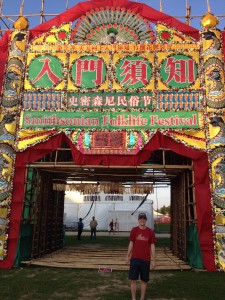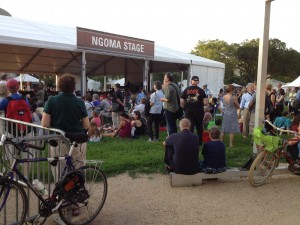We won’t keep off the grass: A day at the folklife festival
08 August 2014 – Will Walker
Coming out of the Smithsonian Metro station on the National Mall, we were immediately drawn to the massive flower plaque bursting with colorful fabric art. Its sound beckoned us, as hundreds of bamboo wind chimes rattled in the breeze. In China, “flower plaques are decorated bamboo structures used for celebrations such as business openings, weddings, or anniversaries.” This one had been designed by Hong Kong-based artist Danny Yung. A dramatic showpiece for this year’s Smithsonian Folklife Festival, it was an eye-catching announcement that something different, and special, was happening in this space and that we were invited to check it out.
My father, sister, and I had risen early that morning and driven from New York to DC for this moment. A decade earlier, I had attended my first festival as a graduate student beginning a history of Smithsonian cultural exhibitions that eventually became a book called A Living Exhibition. Since then, I’ve tried to make it back at least every other year, a goal that has been difficult to achieve since I’ve mostly lived pretty far from DC. I was always confident, though, that if I missed it one year, the festival would still be there the next. Now, I wasn’t so sure. Incredibly, it seemed possible that this might be the last folklife festival on the National Mall. The incentive to attend, therefore, was understandably strong, even if it meant a six-hour drive in heavy traffic.
As this year’s festival was being planned and developed, new National Park Service regulations governing the use of the Mall for public events threatened to displace it permanently from its long-time location in the space between the Smithsonian Castle and National Museum of Natural History. The Park Service is in the midst of a multimillion-dollar renovation of the Mall, which is bringing new grass and drainage to the large ceremonial space between the Capitol and Washington Monument. Along with the new grass come restrictive regulations designed to protect the turf but which may have the practical effect of keeping any event off the Mall whose organizers do not have the resources to pay large fees for grass-shielding materials. The National Book Festival has already gone elsewhere, and it seemed in the weeks leading up to this year’s folklife festival that it might share the same fate.
The Smithsonian Folklife Festival was inaugurated in 1967 under a different name, the Festival of American Folklife. Although relatively small compared to its present incarnation, it was, even then, a vibrant and popular event that drew large numbers of visitors. A combination of the Newport Folk Festival, an outdoor living history museum, and a county fair, the festival was an exhibition like no other. At the heart of the folklife festival, both past and present, is the dynamic interaction of people: visitors and cultural practitioners (the technical term for the musicians, dancers, potters, weavers, sculptors, and storytellers the festival showcases). Deliberately designed to contrast with the static museum displays of the past, it shows what can happen when the exhibits talk back. Today, public historians emphasize the importance of sharing authority and collaborative exhibition development, approaches that the festival’s creators pioneered almost fifty years ago.
The truly remarkable thing about the Smithsonian Folklife Festival, however, is that it is broadly popular across the political spectrum. Members of Congress have routinely praised it, and people of all stripes have enjoyed participating in its programs. In 1976, the festival was the most successful national event created for the bicentennial of the American Revolution. That year, it lasted all summer and drew millions of visitors. Festival creator Ralph Rinzler called it a “festival to cherish our differences.” In a time of disillusionment and racial and ethnic division, the festival had the remarkable effect of bringing together people from a sweeping array of backgrounds in a harmonious, but not superficial, event.
The festival is the greatest museum display of human diversity and creativity in Washington and perhaps the entire country. Its ephemeral nature means that it can be remade every year and, consequently, is able to feature new people and new cultures all the time. A full list of past festival programs is available here. Part of the festival’s appeal is that there is always something new to discover. Consequently, people come back year after year.
This year’s festival highlighted the people, cultures, and traditions of China and Kenya. Beyond the flower plaque, my dad, sister, and I were beckoned by the sound of drums in the Moonrise Pavilion. From there, we moved to a much smaller stage for an intimate and unscripted conversation with Danny Yung and Kenyan soapstone carver Elkana Ong’esa. Here we found exactly what sets the festival apart from most cultural exhibitions–works of art and craft are not simply aesthetic pieces to be admired or ethnographic objects to be studied and contextualized. They are the products of real people who have their own ideas, challenges, and particular stories. Both Yung and Ong’esa did not shy away from discussing social, environmental, and political matters, nor did they attempt to portray themselves as purely “traditional” artists. Through a free-flowing question-and-answer format, the audience got a clear sense of their training, artistic processes, and opinions.
After such a serious discussion, we needed to lighten the mood a bit and headed for the Ngoma performance stage where popular Kenyan singer Eric Wainaina had the entire tent rocking. Wainaina is known for his stance against corruption, but the feel of his band’s performance was celebratory and the audience caught the party spirit. A noticeably integrated crowd danced and bobbed their heads to Wainaina’s groove. Within sight of the Capitol, so often the site of divisive political battles, this musical gathering provided a source of hope and optimism. Without romanticizing tradition, ignoring difference, or forgetting the problems of government in both the United States and Kenya, Wainaina nevertheless made us smile and helped us remember why sharing our cultures is such a vitally important activity.
After our whirlwind one-day trip to DC, we learned that festival administrators had signed a memorandum of agreement with the Park Service to allow the festival to stay on the Mall for five years. The MOA is flawed, though. It restricts festival programs to certain areas, mostly on the sides of the Mall rather than in the center. And it still leaves uncertainty about what will happen after the five years have passed.[1] The choice is simple: should the National Mall be a place for people to gather freely–whether in celebration of cultural diversity or protest against government policies–or should it be a quiet, suburban lawn with a sign that reads “Stay Off the Grass?”
~ Will Walker is assistant professor of history at the Cooperstown Graduate Program (SUNY Oneonta) and a lead editor for History@Work. He is the author of A Living Exhibition: The Smithsonian and the Transformation of the Universal Museum.
[1] The activist group “Save the Festival” is leading an effort to secure a permanent events space on the Mall.






Excellent piece! Thank you for summarizing so effectively why the Folklife Festival is so important and needs to stay on the National Mall.